|
| VISIBLE LASERS ONLY |
The spot is weak but definitely able to
be recognized when the beam hits white
surface and the ambient lights are not
too intense |
0.01 - 0.1 mW |
|
| The laser spot is easy to notice except
maybe a sunny day |
0.1 - 1.0 mW |
|
| The brightness of the spot is comparable
with the very common cheap red laser
pointer or He-Ne laser |
1.0 - 10 mW |
|
| The spot is easy to observe from a
distance even at the surfaces lit by sun |
20 - 100 mW |
|
| ANY LASERS (including infrared and ultraviolet ones) |
Able to lit a match |
50 - 100 mW |
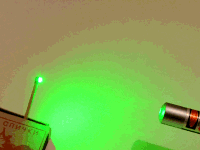 |
| Able to cut down a match into the halves |
600 mW - 1 W |
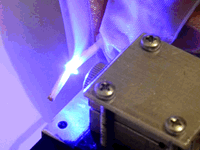 |
| Able to ignite inflammable materials
(like paper, cardboard or plywood) to
visible and stable flame |
> 3W |
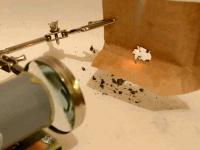 |
Able to cause vigorous burning of
inflammable materials (cardboard,
plywood, etc.) |
10 W |
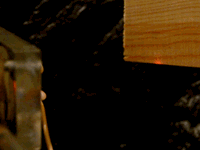 |
| Able to hack down (to slash) a match |
40 W |
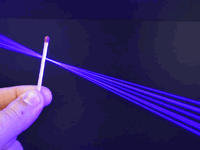 |
COMMENTS:
Understandable that one can visually estimate power of a laser only to a
very rough extent. Especially this is true for the weak visible lasers.
The visibility of the laser spot depends strongly to the wavelength (color),
to the size of the spot, to the reflective and diffusive properties of the
screen, to the power of ambient illumination and even to the individual
specialties of the sight: one may have more sensitive eyes while the other
may have more rough ones. Amazing here the fact that one can certainly see
a spot of a beam having as low power as 10 microwatts and it is still being
sensed as one having "normal" brightness. This fact often misleads people to
attribute microwatt rated lasers as milliwatt ones.
Need to note that the eye sensitivity has logarithmic character. Generally it
means that large differences in power correspond to moderate variations of
visual brightness. And the higher power level we deal with the lower will be
the perceived difference.
The heat action of the laser beam is more objective. But the specialties take
place even here. I.e. the reflectivity of metals grows strongly with growth
of the wavelength. And, say, to burn through a leaf of aluminum foil, an easy
task for some moderate power blue laser pointer, requires serious power from
a neodymium laser, and turns out to be a very hard task to a CO2 laser. On
the contrary CO2 laser easily burns and cuts glass parts, while to do the
same is almost impossible for visible lasers.
All the phenomena, given in the table, are to be made by a focused beam.
One should focus the beam by a lens having its focal length equal to 1..2
inches. Usually, when the necessity appears to estimate a power of some laser
such a lens is easy to get somewhere around. The exclusion may be formed by
CO2 lasers, one must use special lenses for them (like ZnSe or germanium ones)
or by short ultraviolet lasers (fused silica, salt, sapphire).
One may suppose that the possibility to perform a given action by some laser
strongly depends to the sharpness of focus. But in reality it is not completely
true. The mentioned in the table phenomena are to be performed by a laser
and/or the target being handled by hands. Tremor and small errors of aiming
bring all the bonuses of narrow focusing to naught. In practice it is enough
to narrow the beam to 0.3..1 mm. Moreover, the ability of a laser to enflame
something does barely depend to the spot diameter in range between zero and
several millimeters.
Also the possibility to perform one or another action mentioned in the table
should be treated as the possibility to do it without too hard efforts. For
example one can light a match by a 15-20 mW rated He-Ne laser, but it requires
reliable fixation of the laser, the match and the lens. It also requires to
seek a "sweat spot" on the match head. And finally it requires many tries and
waiting for a long time. So hard efforts are out of considerations meant here.
Here is just another video to compare the effect with power. The show was performed with a blue 5W rated laser diode. Evidently the red and infrared lasers won't be able to cut through a steel so easily.
The next video demonstrates capability of laser with power of ~100W
One could say that starting from 100 W and above, laser begins to be able to cut metals of decent thickness with decent speed. However metals have strong spectral dependence of their reflectivity, and what is true for blue laser may be not true for neodymium or CO2 ones. The wood is universal material for any wavelength, but it can be cut easily with 10 W laser or with 100 W one. The difference is only in speed. No quality threshold here.
<< HOME PAGE | 


